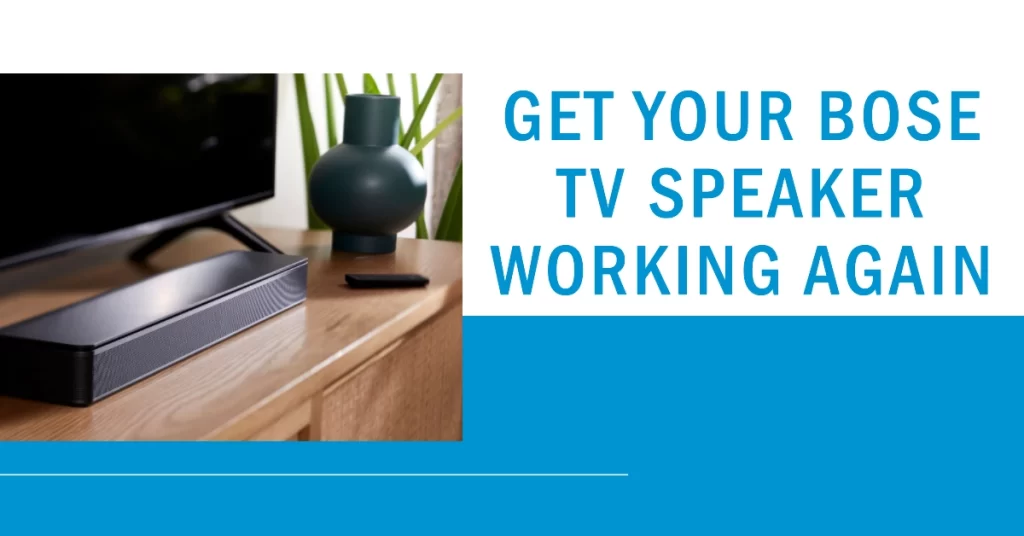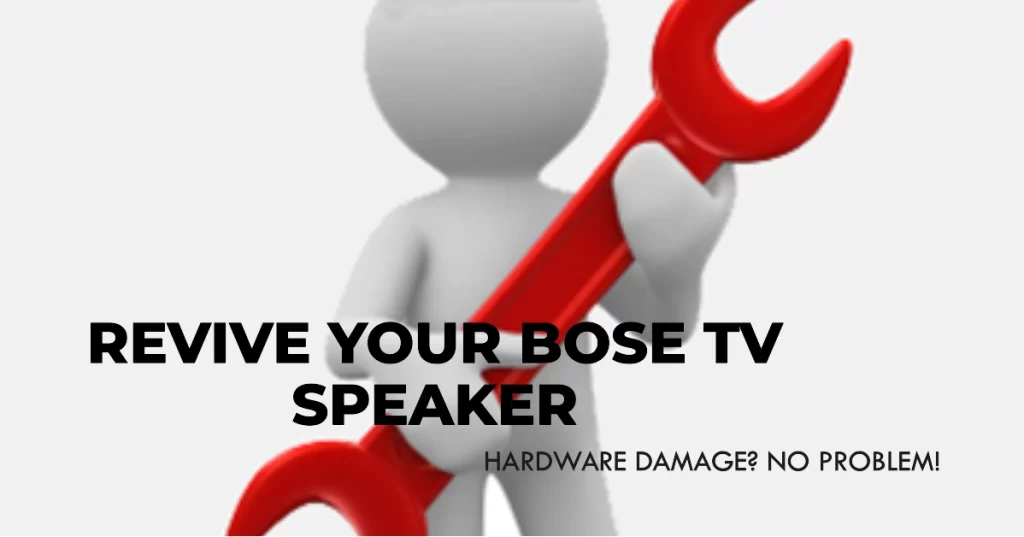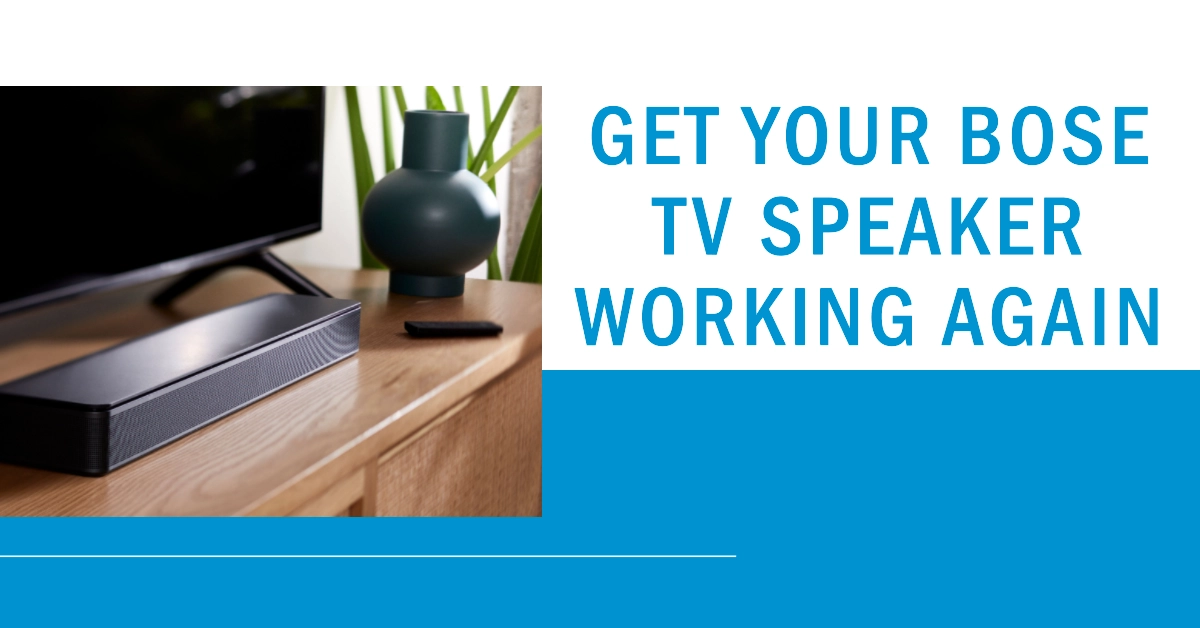Is your Bose TV speaker suddenly emitting no audio at all? Don’t lose hope – some simple troubleshooting at home can often restore its sound.

Few things are more irritating than your Bose TV speaker inexplicably going silent and outputting no sound at all. No matter what you watch or listen to through the speaker, it remains stubbornly mute. Of course a sound system is useless without, well, sound!
But before you contact Bose support or buy a new speaker, there are several quick DIY troubleshooting steps that often resolve sound issues and restore audio from your Bose TV speaker. Let’s discuss what may be causing problems and how to get your speaker sounding great again.
Why Did My Bose TV Speaker Go Silent?
The simplest way to troubleshoot no sound/no audio problem on Bose TV speaker is to determine the underlying cause. This denotes the need for you to recall when and how the problem started. If you couldn’t figure out the root cause, then you better rule out every possible culprit one by one.
Here are the common reasons for a Bose TV speaker losing audio include:
- Loose wired connections needing reseating
- Pairing or input mode lost needing reset
- Faulty cables that need swapping out
- Glitchy firmware needing a software update
- Failing speaker components or electronics
By understanding the root cause, you can better address it. So let’s fix it now!
Quick Fixes to Restore Sound
The following are basic tweaks that you can do to eliminate common factors that may be preventing your speaker to omit sound as intended.
Try these simple solutions for a Bose TV speaker without sound:
1. Inspect connections and firmly push/twist cables into ports
Lose connections could be the main reason why you don’t hear any sound coming from your speaker. Thus, thoroughly inspect cable connections between your speaker and television.
Inspecting physical connections can help deal with no sound problems on a Bose TV speaker in the following ways:
- Loose or disconnected cables. If a cable is loose or disconnected, it can prevent sound from being transmitted from the soundbar to the TV. Check the seating of all cables at both ends to make sure they are properly connected.
- Incorrect cable connections. Make sure that the cables are connected to the correct ports on the soundbar and TV. For example, the HDMI cable should be connected to the HDMI OUT port on the soundbar and the HDMI IN port on the TV.
- Damaged cables. Inspect the cables for any signs of damage, such as kinks, cuts, or fraying. If a cable is damaged, it will need to be replaced.
To inspect the physical connections on a Bose TV speaker:
- Disconnect all cables from the soundbar and TV.
- Inspect the cables for any signs of damage. If a cable is damaged, replace it.
- Connect the cables to the correct ports on the soundbar and TV.
- Make sure that all cables are properly seated.
- Turn on the soundbar and TV.
Here are some additional tips for inspecting physical connections:
- Use a flashlight to inspect the connections in hard-to-see areas.
- Try wiggling the cables slightly to see if they are loose.
- If you are using an HDMI cable, try connecting it to a different HDMI port on the TV.
- If you have multiple devices connected to the soundbar, try disconnecting them one at a time to see if that resolves the issue.
If you have inspected all of the physical connections and you are still having no sound problems, it is possible that there is a problem with the soundbar itself. In this case, you may try some other ways to fix the problem.
2. Toggle TV speaker power and input modes off and on
Toggling the TV speaker power and input modes off and on can help deal with no sound problems on a Bose TV speaker in a few ways:
- It can reset any temporary glitches or errors that may be preventing the speaker from producing sound.
- It can ensure that the speaker is properly connected to the TV and other devices.
- It can cycle through the different input modes to make sure that the speaker is receiving the correct audio signal.
To toggle the TV speaker power and input modes off and on, follow these steps:
- Turn off the TV speaker using the remote control or the power button on the speaker itself.
- Disconnect the power cord from the TV speaker.
- Wait for at least 30 seconds.
- Reconnect the power cord to the TV speaker.
- Turn on the TV speaker using the remote control or the power button on the speaker itself.
- Press the source button on the remote control to cycle through the different input modes.
3. Try different input cables like optical or HDMI ARC
Trying different input cables like optical or HDMI ARC can help deal with no sound problems on a Bose TV speaker in the following ways:
- HDMI ARC: HDMI ARC stands for HDMI Audio Return Channel. It is a feature that allows audio to be returned from the TV to the soundbar over the same HDMI cable that is used to send video from the source device to the TV. This eliminates the need for a separate audio cable.
If you are using HDMI ARC to connect your Bose TV speaker to your TV, but you are not getting any sound, it is possible that there is a problem with the HDMI cable itself. Trying a different HDMI cable, especially a high-speed HDMI cable, can help to resolve the issue.
- Optical: Optical cables are a type of digital audio cable that uses light to transmit audio signals. They are less susceptible to interference than analog audio cables, such as RCA cables.
If you are using an optical cable to connect your Bose TV speaker to your TV, but you are not getting any sound, it is possible that there is a problem with the optical cable itself. Trying a different optical cable can help to resolve the issue.
4. Factory reset the speaker by pressing mute and volume down buttons
Factory resetting your Bose TV speaker can help deal with no sound or audio problems in a number of ways:
- It can clear any temporary glitches or software errors that may be causing the problem.
- It can restore the speaker to its default settings, which may resolve any configuration issues.
- It can reset the speaker’s audio output settings, which may fix any problems with the speaker connecting to your TV or other audio devices.
To factory reset your Bose TV speaker, follow these steps:
- Power off your speaker.
- Disconnect the power cord from the back of the speaker or the power outlet.
- Wait 5 minutes.
- Reconnect the power cord.
- An ascending tone is heard within 10 seconds to confirm power is connected.
- Wait 30 seconds.
- Resume normal use of your speaker.
Once your speaker has reset, try playing some audio to see if the problem has been resolved.
5. Update Bose speaker firmware from smartphone app or via USB
Updating the firmware on your Bose speaker can help to fix a variety of audio problems, including no sound. Firmware updates can include bug fixes, performance improvements, and new features. In some cases, firmware updates can also fix specific audio problems that have been reported by users.
Here are some of the ways that updating the Bose speaker firmware can help to deal with no sound or audio problems:
- Fix bugs that are preventing the speaker from producing sound.
- Improve the compatibility of the speaker with other devices.
- Update the audio drivers for the speaker.
- Resolve audio problems that are caused by specific software or hardware configurations.
If you are experiencing no sound or audio problems with your Bose speaker, it is likewise a good idea to check for and install any available firmware updates. You can check for firmware updates on the Bose website or through the Bose Connect app.
With some luck, one of these easy steps will have your audio flowing again instantly. However, if you have tried all of the above and you are still experiencing no sound or audio problems with your Bose speaker, you may need to contact Bose customer support for further assistance.

When Professional Service May Be Needed when dealing with Bose TV speaker no sound issue
Pinpointing hardware issues ensures proper service. If problems persist after troubleshooting, a repair may be required:
- Contact Bose support online for warranty evaluation
- Visit a Bose authorized service center for inspection
- Consider component-level repair of any damaged speakers/electronics
- Purchase replacement cables to rule out a faulty one
Generally, a Bose TV speaker that’s failing to emit audio may seem like a lost cause, but pragmatic troubleshooting can isolate the issue in many cases. Verify connections, toggle power modes, factory reset, update firmware. With diligence and patience, you can likely have your speaker sounding crisp again in no time.
